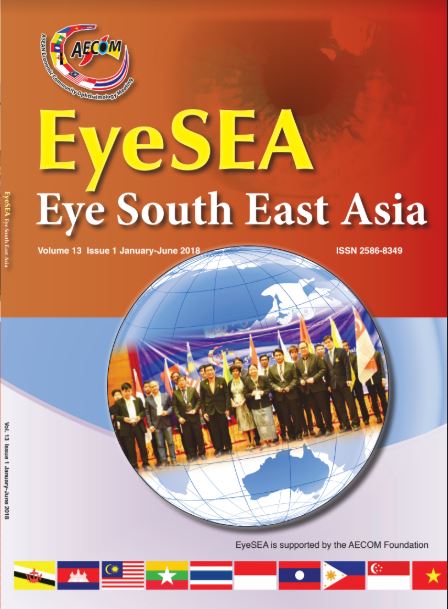Macular ganglion cell and retinal nerve fiber layer thickness in normal Vietnamese children measured with optical coherence tomography.
Main Article Content
Abstract
Purpose: To obtain the macular ganglion cell–inner plexiform layer (GC–IPL) and the retinal nerve fiber layer (RNFL) thickness normative values of Vietnamese children.
Methods: A cross–sectional study was conducted on 152 healthy eyes from 76 children aged between 6 and 16 years. The macular ganglion cell–inner plexiform layer and the retinal nerve fiber layer thickness were measured by a spectral domain Cirrus high definition optical coherence tomography (version 10.5). Only scans with signal strength > 6/10 were included.
Results: The mean age was 10.13±2.47 years and the mean spherical equivalent refraction was –1.05 ± 1.27D. The average and minimum GC–IPL thickness were 84.74±5.17µm and 80.18±7.84µm, respectively. The average RNFL thickness was 103.18 ± 9.50µm. The mean central macular thickness was 240.51±15.47µm. The rim area was correlated with the average RNFL (ß=13.742, p<0,001). Age, spherical equivalent refraction and gender were correlated with the central macular thickness (ß= –1.437, p<0.01, ß= –5.204, p<0.001 and ß =5.660, p<0.02). The minimum GC–IPL thickness was not effected by gender, age and spherical equivalent refraction.
Conclusion: This study provides normative GC–IPL and RNFL thickness values for Vietnamese children. It may assist in identifying changes in GC–IPL and RNFL thickness in children. The rim area had correlated with RNFL thickness while the spherical equivalent refraction and gender had related with the central macular thickness. The minimum GC–IPL can be used in managing pediatric glaucoma patients.
Conflict of interest: none.
Article Details
References
2. Aref AA, Budenz DL. Spectral Domain Optical Coherence Tomography in the Diagnosis and Management of Glaucoma. Ophthalmic Surg Lasers Imaging. 2010; 41:S15-27.
3. Curcio CA, Allen KA. Topography of ganglion cells in human retina. J Comp Neurol. 1990; 300:5-25.
4. Goh JP, Koh V, Chan YH. Macular Ganglion Cell and Retinal Nerve Fiber Layer Thickness in Children With Refractive Errors-An Optical Coherence Tomography Study. J Glaucoma. 2017; 26:619-625.
5. Lee SY, Jeoung JW, Park KH. Macular ganglion cell imaging study: interocular symmetry of ganglion cell-inner plexiform layer thickness in normal healthy eyes. Am J Ophthalmol. 2015; 159:315-23.e2.
6. Leung MM, Huang RY, Lam AK. Retinal nerve fiber layer thickness in normal Hong Kong chinese children measured with optical coherence tomography. J Glaucoma. 2010;19:95-9.
7. Neelam P, Devendra M, Meenakshi R. Retinal nerve fiber layer thickness in normal Indian pediatric population measured with optical coherence tomography. Indian Journal of Ophthalmology. 2014;62:412-418.
8. Salchow DJ, Oleynikov YS, Chiang MF. Retinal nerve fiber layer thickness in normal children measured with optical coherence tomography. Ophthalmology. 2006;113:786-91.
9. Tariq YM, Li H, Burlutsky G. Retinal nerve fiber layer and optic disc measurements by spectral domain OCT: normative values and associations in young adults. Eye. 2012;26:1563-1570.
10. Totan Y, Guragac FB, Guler E. Evaluation of the retinal ganglion cell layer thickness in healthy Turkish children. J Glaucoma. 2015;24:103-8.
11. Ooto S, Hangai M, Sakamoto A. Three-Dimensional Profile of Macular Retinal Thickness in Normal Japanese Eyes. IVOS Journal. 2010; 51:465-473.
12. Rosenfelda PJ, Durbinb MK, Roismana L. ZEISS AngioplexTM Spectral Domain Optical Coherence Tomography Angiography: Technical Aspects. Dev Ophthalmol. 2016;56:18–29.
13. Zhang Z, He X, Zhu J. Macular Measurements Using Optical Coherence Tomography in Healthy Chinese School Age Children. IVOS Journal. 2011;52:6377-83.


